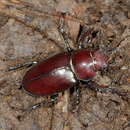en
names in breadcrumbs


Communication Channels: visual ; tactile ; chemical
Perception Channels: visual ; tactile ; vibrations ; chemical
This species is uncommon, but not believed to be in need of special conservation efforts.
US Federal List: no special status
CITES: no special status
Giant stag beetle larvae hatch from eggs laid by females on suitable dead trees. They then eat and grow for several years in dead tree stumps. When fully-grown, the larvae pupate for seven to nine months, emerging the following June. After their emergence they live for about three to five weeks more.
Development - Life Cycle: metamorphosis ; diapause
Though startling if found unexpectedly, these big beetles have no significant adverse effects on humans. They can pinch hard if handled carelessly, but only bite in self-defense.
Negative Impacts: injures humans (bites or stings)
These large beetles are collected and raised by hobbyists. In the wild they can be important agents of wood decomposition.
Adult elephant stag beetles, like most stag beetles, feed on sugary liquid foods, mainly sap leaking from wounded trees, aphid "honeydew" secretions, and ripe fruit. They cannot chew food. The larvae feed on wet, decaying wood, probably getting nutrition from the wood and the fungi and microbes that are decomposing it.
Plant Foods: wood, bark, or stems; fruit; sap or other plant fluids
Other Foods: fungus; microbes
Primary Diet: herbivore (Lignivore, Eats sap or other plant foods)
The giant stag beetle, also known as the elephant stag beetle, can be found in the woodlands of North America ranging from Virginia and North Carolina to the northeastern United States.
Biogeographic Regions: nearctic (Native )
These beetles live and reproduce in damp, rotting wood.
Habitat Regions: temperate
Terrestrial Biomes: forest
Adult males are 45-60 mm long; females are smaller, around 30-35 mm. This species has a slender, elongated form, with a somewhat flattened back. Adults are reddish-brown, shiny, and have black antennae and legs. Males have a crest above their eyes and a wide head. They are distinguished by their giant antlerlike jaws that may be as long as the head and thorax combined. These jaws have small forked teeth along the inner edge. The females have a narrower head than thorax and much smaller jaws than males. Female elytra are lightly punctate. Giant stag beetles have the segments of their antennae separated rather than compacted like scarab beetles do.
Larvae are white and grub-like, and are characterized by the absence of a 6th segment in the leg.
Range length: 30 to 60 mm.
Other Physical Features: ectothermic ; heterothermic ; bilateral symmetry
Sexual Dimorphism: male larger; ornamentation
Males use their giant jaws to fight for access to females. Individual males try to control a dead tree or stump suitable for egg-laying, preventing other males from mating with the females arriving on the tree. Consequently one male usually mates with multiple females.
Mating System: polygynous
Female stag beetles lay their eggs on dead trees or stumps that will provide suitable food and protection for their offspring. In temperate climates, adults only live for a single breeding season.
Breeding season: In temperate climates, stag beetles breed in the summer months.
Key Reproductive Features: semelparous ; seasonal breeding ; gonochoric/gonochoristic/dioecious (sexes separate); sexual ; fertilization (Internal ); oviparous
Eggs laid by female stag beetles are supplied with a small amount of nourishing yolk, but the beetle larvae hatch quickly, and receive no additional care. Male stag beetles do not care for their offspring.
Parental Investment: pre-fertilization (Provisioning, Protecting: Female)
Lucanus elaphus, the giant stag beetle, is a beetle of the family Lucanidae native to eastern North America.[1][2] They are sometimes kept as pets.
Elaphus in Greek means "deer".[3] Compare with the Red Deer (Cervus elaphus), 'cervus' meaning 'deer' in Latin.
Lucanus elaphus, the giant stag beetle, is a beetle of the family Lucanidae native to eastern North America. They are sometimes kept as pets.